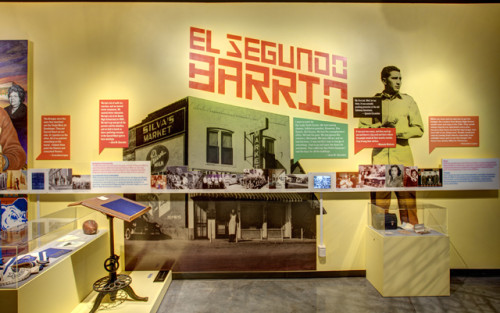
Neighborhoods and Shared Memories/Nuestros vecindarios y sus memorias
C&G Partners, New York, New York, 2012
Description
“Neighborhoods and Shared Memories” (Nuestros vecindarios y sus memorias) is a community-sourced exhibit that empowers its members to tell the story of their neighborhoods in their own words. Researchers from the design team, working with the museum's researchers, gave shape to this collection through the grouping of stories and artifacts around themes that emerge from the collection overall. This is a significant break from the more traditional museum exhibits where a curatorial team establishes an exhibit’s story lines; with “Neighborhoods and Shared Memories,” the community is the curator.
We worked with a plurality of voices that do not necessarily build a single narrative, but rather create a web of themes that will carry on for the museum as the project continues, in future iterations, to examine El Paso's other neighborhoods and districts. Like a casual visit to a neighborhood, where locals approach you and tell you local history from their perspective, the emphasis is on the experience of interpreting a community through the images and stories its members share. The “take away” for the visitors lies in the broadness and authenticity of the experience, and less a linear, certifiable narrative.
The exhibit is, partially, temporary. Every 18 months, a new set of neighborhoods will be on display. The exhibit furniture and casework is designed to be entirely adaptable to new configurations of artifacts and media. Eighty percent of the exhibit space is fitted for this interchangeability. The strategy saves money and material for future neighborhood exhibits. The “fixed” displays in the museum are minimal, drawing from the Museum’s own collections and giving an overall geographic shape to the program:
-a large-scale historical map from the museum collection, specially restored for this exhibit
-an animation which shows the physical history of El Paso, which required original historical research from the museum staff
-a vinyl tile floor map where children can play and rebuild the city with rubber blocks modeled after landmark buildings or typical building types
-an information table with four computer stations linking to the exhibit website, which serves as an archive for all the interviews and photos collected for the project
The changeable portion of the exhibits include two display walls along the longer sides of the gallery, an oral history theater in the center and a “message wall” at the back of the gallery. Each of the display walls is dedicated to one of the two “showcased” neighborhoods. Everything on display comes from the community. On the two display walls, the principal elements are large-scale murals, a linear display of photographs, and cases and platforms for the display of artifacts. The linear display of photographs is designed as a single gesture that spans an entire wall. We internally call it the “shelf” because it aligns the images along the bottom border. The pictures sit on this line like a shelf. The shelf also contains digital picture frames which allow for a continual display of more images pulled from the archive and from new images that were recently sent to the museum by community groups wishing to add to the exhibit. The murals serve as visual markers for the organizational themes, while the two murals that dominate the main exhibit space are commissioned from artists working in the districts.
The exhibit is entirely bilingual.
Read the full case study with juror comments here: [http://www.aiga.org/justified-2012--case-study--neighborhoods-and-shared-memories/]
Credits
- Design firm
- C&G Partners
- Client
- El Paso Museum of History





